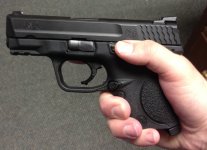mjsmith1223
Member
So, I am sort of new to pistols. Always been a rifle/shotgun guy. The handgun discipline is an exciting new adventure for me.
What does a proper grip on the M&P look like? Last night I was shooting with the pistol group at my club and one of the instructors told me I need to work on my grip and get it higher on the gun. How do I do that so it becomes second nature and I don't have to think about it?
Before the pistol group, I was doing some shooting on my own and noticed I was consistently left. I suspect the problem is with me and the way I was pulling the trigger. Which part of my finger should be on the trigger? The fatty part or the crook (for lack of a better term)? I know it needs to go straight back and I work on that. The old "breathe in, breathe out, squeeze" from my rifle shooting doesn't seem to directly translate.
Just for information: I have an M&P 9c and that's what I was shooting last night. In spite of all the rookie errors, it still functioned flawlessly.
What does a proper grip on the M&P look like? Last night I was shooting with the pistol group at my club and one of the instructors told me I need to work on my grip and get it higher on the gun. How do I do that so it becomes second nature and I don't have to think about it?
Before the pistol group, I was doing some shooting on my own and noticed I was consistently left. I suspect the problem is with me and the way I was pulling the trigger. Which part of my finger should be on the trigger? The fatty part or the crook (for lack of a better term)? I know it needs to go straight back and I work on that. The old "breathe in, breathe out, squeeze" from my rifle shooting doesn't seem to directly translate.
Just for information: I have an M&P 9c and that's what I was shooting last night. In spite of all the rookie errors, it still functioned flawlessly.






